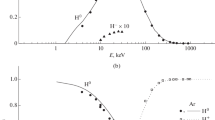Abstract
A correction to the Bohr formula making it possible to explain the difference between the stopping powers of positively and negatively charged particles (the Barkas effect) is obtained in the quasiclassical approximation taking into account the difference between electron motion in a hydrogen atom as a function of the charge sign of the moving particle. The influence on the atomic electron of the moving particle leads to a change in the contribution of the adiabatic interaction, in the case of which the energy is not transferred in the majority of collisions, which is the reason for a decrease in the energy losses of slow particles compared with Bohr theory. The results of calculations show that the energy losses per path length unit can be represented in the form of the product of two functions, namely, the energy loss function (in accordance with Bohr theory) and the dynamic function taking into account corrections related to correction of the electron position in the target atom during the collision. Calculations carried out within the framework of classical dynamics make it possible to qualitatively estimate differences between the interaction of protons and antiprotons with target material atoms.
Similar content being viewed by others
References
N. Bohr, Collected Works, Vol. 8: The Penetration of Charged Particles Through Matter (1912–1954) (North-Holland, Amsterdam, 1987).
H. Beth., Ann. Phys. 5, 325 (1930)
H. Bethe, Z. Phys. 76, 293 (1932).
H. Bethe and J. Ashkin, in Experimental Nuclear Physics, Ed. by E. Serge (Wiley, New York, 1953).
J. Lindhar., Nucl. Instrum. Methods 132, 1 (1976).
W. Wilhelm, H. Daniel, and F. Hartma., Phys. Lett. B 98 (1–2), 33 (1981).
W. H. Barkas, W. Birnbaum, and F. M. Smit., Phys. Rev. 101, 778 (1956).
W. H. Barkas, N. J. Dyer, and H. H. Heckma., Phys. Rev. Lett. 11, 26 (1963).
P. Sigmund and A. Schinner, in Fundamental and Applied Aspects of Modern Physics, Ed. by S. H. Connell and R. Tegen (World Scientific, London, Singapore, 2001), p.178.
L. D. Landau and E. M. Lifshits, Course of Theoretical Physics, Vol. 3: Quantum Mechanics: Non-Relativistic Theory (Pergamon Press, Oxford, 1977).
A. Adamo, F. Agnello, F. Balestra, G. Belli, G. Bendiscioli, A. Bertin, P. Boccaccio, G. C. Bonazzola, T. Bressani, M. Brusch, et al., Phys. Rev. A 47 (5), 4517 (1993).
M. Angello, G. Belli, G. Bendiscioli, A. Bertin, E. Botta, T. Bressani, M. Bruschi, M. P. Bussa, L. Busso, D. Calvo, et al., Phys. Rev. Lett. 74 (3), 371 (1995).
J. F. Ziegler, J. P. Biersack, and M. D. Ziegler, SRIM–The Stopping and Range of Ions in Matter (SRIM, Chester, MD, 2008).
K. M. Erokhin and N. P. Kalashniko., Vest. Nats. Issled. Yad. Univ. “MIFI” 4 (3), 193 (2015).
I. Newton, Philosophiæ Naturalis Principia Mathematica (Londini, Jussu Societatis Regiæ ac Typis Josephi Streater. Prostat apud plures Bibliopolas, 1687).
H. Poincaré, Selected Works in Three Volumes, Vol. 1: New Methods of Celestial Mechanics (Springer, Berlin, Heidelberg, 2014).
D. Kleppner, M. G. Liftman, and M. L. Zimmerma., Sci. Am. 244, 130 (1981).
Author information
Authors and Affiliations
Corresponding author
Additional information
Original Russian Text © K.M. Erokhin, N.P. Kalashnikov, 2017, published in Poverkhnost’, 2017, No. 5, pp. 91–98.
Rights and permissions
About this article
Cite this article
Erokhin, K.M., Kalashnikov, N.P. Quasiclassical approach to the interpretation of the Barkas effect. J. Surf. Investig. 11, 562–569 (2017). https://doi.org/10.1134/S1027451017030065
Received:
Published:
Issue Date:
DOI: https://doi.org/10.1134/S1027451017030065




